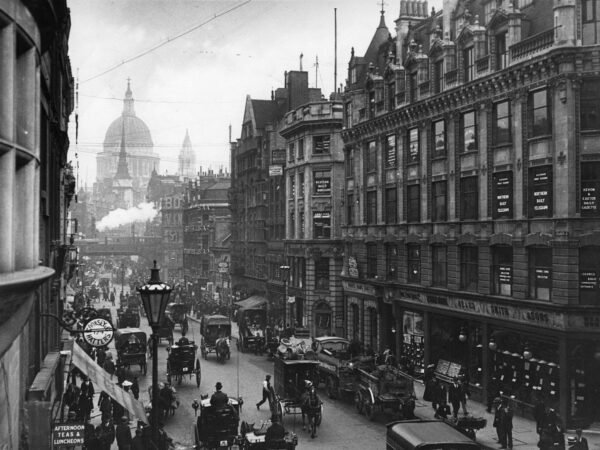Locations
Beaconsfield
Chesterton’s many commitments, his frantic literary, press and public activity, but first and foremost, the bohemian and debauched environment around Fleet Street’s taverns, pubs and restaurants, led to him moving with Frances, in 1909, from their home in Battersea to Beaconsfield. This town, some 40 kilometres northwest of London, is linked by train to the City, and Chesterton made the trip by these means from Beaconsfield Station to the London stop of Marylebone. They rented a house, Overroads, and then purchased a plot in front of it, where they first built a large study where they celebrated Christmas parties with their friends’ sons. In 1922 they moved to a new house, Top Meadow, built right next to the study. On the same year, in a room at the Railway hotel, he formally converted to Catholicism. The construction of St Teresa’s Catholic Church in Beaconsfield was made possible by the Chestertons’ economic contribution. Gilbert, Frances and their goddaughter Dorothy Collins, his last secretary, are buried in the town’s Sheperds Lane Cemetery.
London

Fleet Street
London is a city closely associated with Chesterton’s life and work: he grew up as a kid in Campden Hill and lived until married in the two family homes of Sheffield Terrace and Warwick Gardens, in Kensington. Overstrand Mansions, in Battersea, was his marital home until he moved with Frances to Beaconsfield. Fleet Street, the site of the newsrooms of the main London newspapers, was the place where Gilbert spent the day, reading, writing or arguing with friends and journalists in the taverns or pubs. Other places he frequented were theatres, halls, churches and literary, cultural or religious associations where he gave lectures and took part in rallies, events or debates. Amongst his novels, The Napoleon of Notting Hill (1904), The Man Who Was Thursday: A Nightmare (1908) y The Ball and the Cross (1909) are set in London. In 1906 he wrote the introduction to the book Literary London, by E. M. Lang, and published London, in a private edition, in 1914.
England
Chesterton travelled a lot around his country. From his family holidays with his parents during his teenage years, through his marriage with Frances, to the public activities he undertook by giving lectures and taking part in debates, along with his assistance to public events, rallies, electoral campaigns or elections to university rector, Chesterton toured England in its practical entirety. Gilbert also travelled to important cities in England for the promotion and business of the Distributist League. He visited several times Ireland and Scotland.
Catalonia
Chesterton stayed twice in Catalonia, in both cases for different reasons. The first stay, in May 1926, organized by the Catalan section of the PEN Club, was the more official and significant one. It had considerable repercussion in the press and in the cultural and literary circles of the period, and eminently featured the city of Barcelona: its University, the Ateneu Barcelonès, its cafes, the news agents and bookshops, the Rambla. The second one, in 1935, which also took place in spring, was a resting stay, in which he took refuge in Sitges to enjoy the Mediterranean seascape, write, go for walks and forget, for a few weeks, the many engagements overwhelming him.
Trips
Throughout his life Chesterton travelled a lot, both around England and abroad. The trips can be sorted in three categories: the private or family trips, ranging from his teenage years, when he visited many places in England in the summer holidays, to the trips with his father Edward to France and Italy and, already married, his travels with Frances and Dorothy Collins. The second group consists of the trips around England, Ireland and Scotland related to his public activities. These include lectures, events, debates, rallies, elections for rector of a university, political electoral campaigns, the spread of the Distributist League and religious congresses. Finally, because the popularity and appreciation of Chesterton and his work spread overseas, he visited a dozen European countries, some of them two or three times, in addition to the Holy Land, Egypt, Canada and two American tours.
